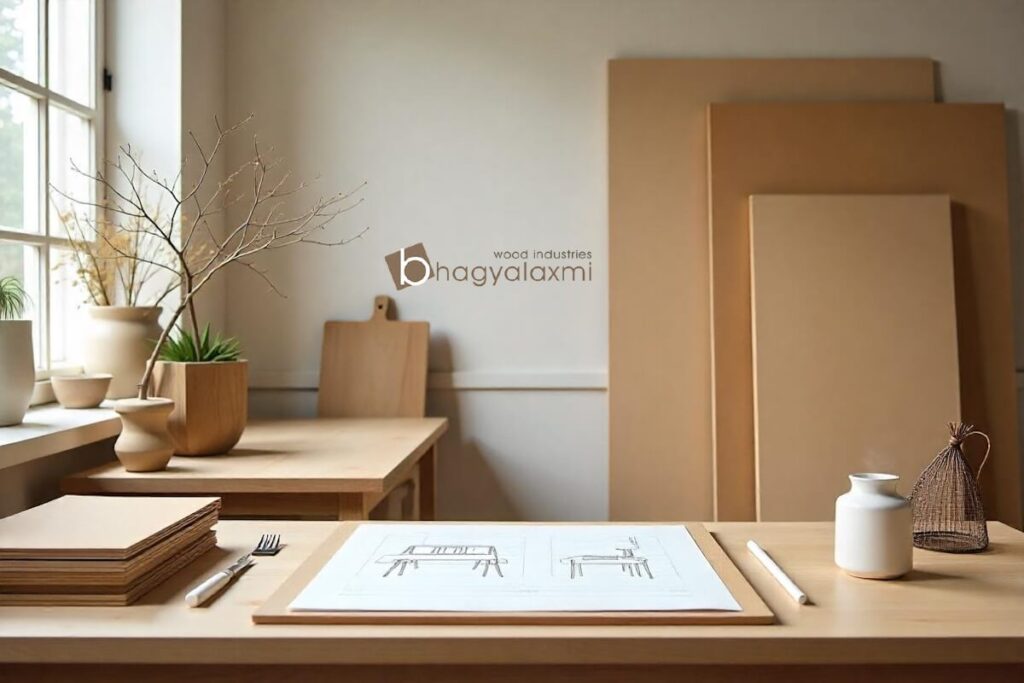
When you think about building furniture, solid wood often comes to mind first. It’s classic, durable, and has been around forever. But there’s another material making waves in carpentry circles: blockboard. Lightweight yet strong, it’s becoming the go-to choice for furniture makers who want practicality without sacrificing style.
Blockboard has found its place in homes, offices, and even commercial spaces. Its versatility makes it suitable for everything from doors and shelves to wardrobes and tables.
So, what’s the deal with blockboard? Why are so many people switching to it? And how does it fare in the debate of blockboard vs solid wood? Let’s unpack all of this and help you decide whether blockboard is right for your next furniture project.
What Exactly is Blockboard?
Blockboard is a type of engineered wood made by sandwiching softwood strips between two layers of thin wood veneer. These strips are laid edge-to-edge and glued together, then topped with veneers to create a flat, sturdy surface.
This unique construction gives blockboard several benefits: it’s lighter than plywood or solid wood, resists bending over long spans, and holds screws and nails well.
In short, blockboard takes the best parts of natural wood and engineered wood, giving you something durable yet manageable for big and small furniture alike.
Wondering if blockboard fits your furniture making requirements? Let us guide you.
Why is Blockboard Popular in Furniture Making?
You’ve probably seen blockboard furniture without even realizing it. Wardrobes, tables, bookshelves, and doors often use this material because it checks so many boxes. Here’s why carpenters and designers love it:
1. Lightweight But Doesn’t Feel Flimsy
Nobody likes lugging around heavy furniture. Blockboard pieces are easier to move and reposition without breaking your back. Yet they’re still strong enough to hold weight without sagging.
2. Stable in Varying Conditions
Unlike solid wood, blockboard doesn’t warp or crack as easily when exposed to moisture or heat. This makes it a smart choice in areas with fluctuating weather.
3. Budget-Friendly Without Looking Cheap
Blockboard is more affordable than solid wood but still gives you the look of premium furniture, especially when finished with veneers or laminates.
4. Ideal for Long Panels
For large surfaces like doors or tables, blockboard’s construction prevents bending or splitting across its length.
Common Applications of Blockboard
Blockboard isn’t a niche product—it’s widely used in both residential and commercial furniture. Here are some common areas where it shines:
- Doors: Stays straight and resists sagging over time.
- Tables and Desks: Offers a wide, flat surface without becoming overly heavy.
- Shelving Units: Can handle books and decor while staying lightweight.
- Partitions: A cost-effective way to create room dividers.
- Wall Paneling: Smooth finish makes it perfect for decorative panels.
If you’re working on custom furniture, it’s worth asking your carpenter whether blockboard fits the design.
Blockboard vs Solid Wood: Which is Better?
This is the big question for anyone comparing materials. Let’s break it down:
| Feature | Blockboard | Solid Wood |
|---|---|---|
| Weight | Lightweight, easy to handle | Heavy, harder to move |
| Durability | Very durable for everyday use | Extremely durable, long-lasting |
| Moisture Resistance | Resists warping in most cases | Prone to warping and cracking |
| Cost | More affordable | Expensive |
| Aesthetic Appeal | Depends on finish (veneer/laminate) | Naturally beautiful |
| Best Use | Large panels, modern furniture | Heirloom pieces, premium furniture |
Verdict: If you’re after affordability, ease of use, and stability for modern furniture, blockboard is a smart pick. For traditional, high-end furniture meant to last decades, solid wood still has the edge.
Still deciding between blockboard and solid wood? We can help.
Myths About Blockboard
Let’s clear up some common misconceptions:
- “Blockboard is weak.”
Not true. A good-quality blockboard is plenty strong for most furniture applications. - “It’s only for cheap furniture.”
Again, no. Many premium furniture makers use blockboard with high-end veneers to create stunning pieces. - “It can’t hold screws.”
If the core is dense and the screws are placed properly, blockboard holds fasteners securely.
Tips for Choosing Quality Blockboard
Not all blockboards are made the same. Here’s what to look for:
- Check the Core Strips
The softwood strips should be uniform and tightly packed with minimal gaps. - Inspect the Surface
Veneers should be smooth, well-bonded, and free from bubbles or cracks. - Ask About the Adhesive
For kitchens or bathrooms, moisture-resistant (MR) grade or boiling water-resistant (BWR) grade blockboard is recommended.
Caring for Blockboard Furniture
To keep your blockboard furniture in great shape:
- Clean with a soft, damp cloth. Avoid soaking it.
- Don’t drag heavy objects across the surface.
- Use coasters and mats to prevent heat or moisture damage.
With minimal care, blockboard furniture can last many years.
So, Should You Go for Blockboard?
If you’re looking for furniture that’s lightweight, affordable, and durable for daily use, blockboard is an excellent choice. It works especially well for modern designs and large structures like doors, cabinets, and shelving.
Of course, if you’re after a rustic, natural wood feel and have the budget for it, solid wood might still be worth the splurge. But for most homes and offices, blockboard offers the perfect balance of strength, style, and price.
Final Thoughts
Blockboard might not have the old-world charm of solid wood, but it delivers on practicality and style. Whether you’re renovating your home, setting up an office, or designing custom furniture, this material deserves serious consideration.
Start building furniture you’ll love. Get in touch with us.
